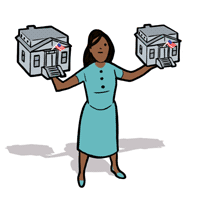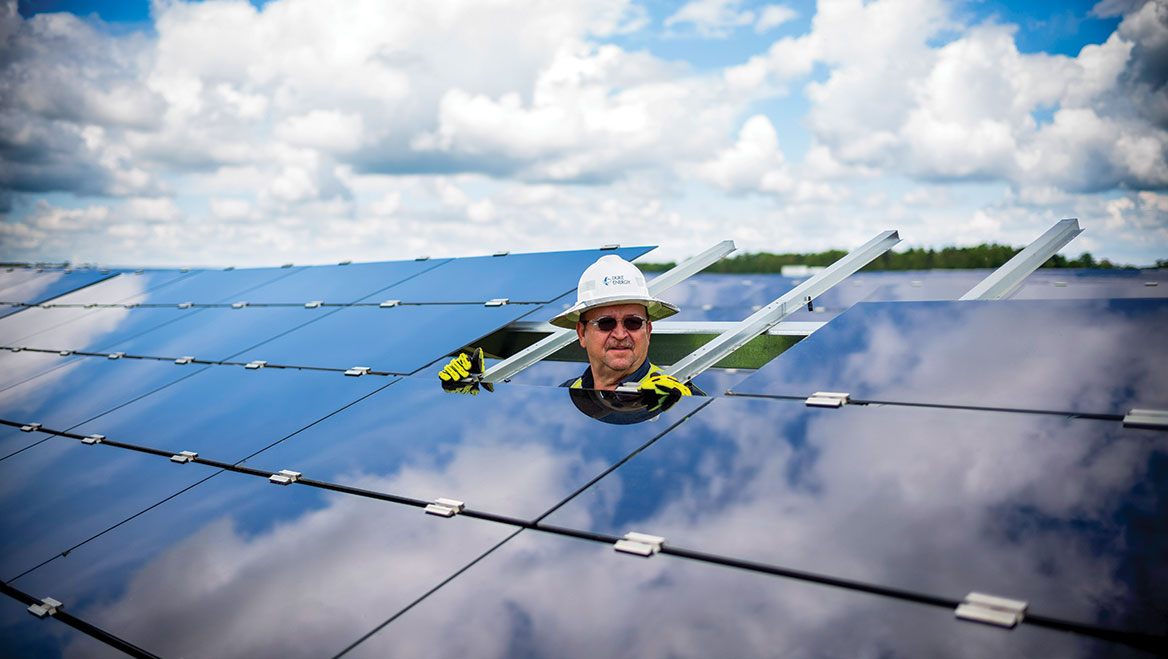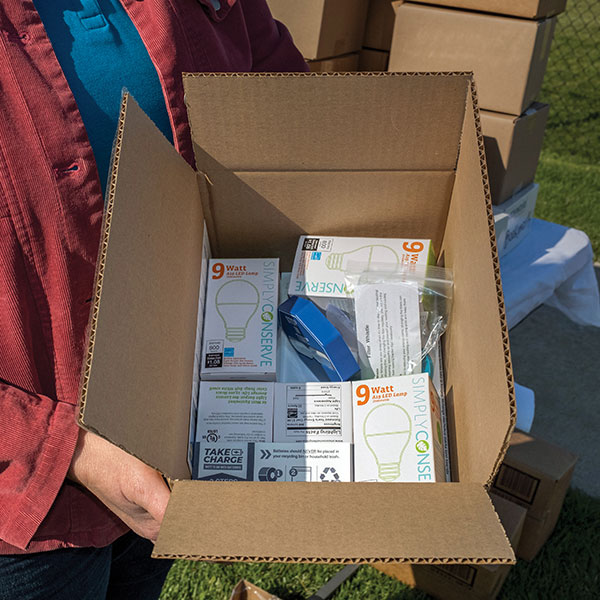Part of the Disruptors Series
Sept. 16, 2021
In the partisan upheaval of recent years, the existential threats of climate change have taken a back seat to the existential threats besieging democracy. Climate action has surged back as a priority under the current administration, but with a large swath of the nation indifferent, if not opposed, to that agenda, progress at the federal level is uncertain. This uncertainty is intensified by the constant flip-flopping of policy as control of Congress and the White House swings back and forth across the partisan divide. Progress on generational challenges like climate change requires long-term political stability, which fortunately can still be found at the municipal level of American politics.
Chris Rhie, an associate principal and energy specialist at the consulting firm Buro Happold, believes this trend is unlikely to shift anytime soon. "I remember when the George W. Bush administration stopped the U.S. from joining the Kyoto protocol and it was folks like Mayor Greg Nickels of Seattle and John Hickenlooper, who was mayor of Denver at the time, who took up the mantle," says Rhie. "When the Trump administration, surrounded by a lot of climate deniers, wanted to pull out of another international agreement, city leaders again said, 'Look, if the federal government is not going to take action, we're going to do it ourselves.' It's cyclical."
Public trust in government is greatest at the local level, and the impacts of climate change are by nature local, so it makes sense for cities to take the lead. "Climate impacts on infrastructure happen at the local level and have to be paid for largely at the local level," says Samantha Harkins, the former deputy mayor of Lansing, Michigan, and the founder of Hundred Place Consulting. "As a resident, you expect to be able to travel on roads that aren't collapsed from inclement weather, and that there's a plan in place for the next time that happens. Local governments are being forced to adapt."
To adapt successfully, however, means navigating the choppy waters of regional, state, and national politics with which municipalities are inextricably bound. Red states, for instance, are increasingly preempting local control in their blue cities on partisan issues like climate change. Two-thirds of major American cities are not on track to achieve their published greenhouse gas emissions goals, according to "Pledges and Progress," a 2020 Brookings Institution report. Of the findings, Brookings Senior Fellow Mark Muro told the Washington Post that, "Having a well-intentioned, well-researched commitment is different from having a plan for execution — that's where cities are struggling."

Public trust in the federal government is declining, while trust in local governments remains high. Local governments and planning organizations should continue to foster that trust by listening to their community members; focusing on local goals, visions, and needs; and building confidence in their work through implementation of projects and initiatives.
Montgomery County, Maryland, known for having some of the most ambitious climate goals in the country — including reducing emissions 80 percent in a decade — has made scant progress since 2017, when the target was set. Much of the reductions will have to come from buildings emissions, but the county council has met with stiff resistance from the local building industry. For years, the county sought to establish the Community Choice Aggregator Pilot Program (a novel initiative in which the government pools the electricity demand of its residents to enable increased adoption of renewable energy), but it required approval by the state senate, which was not forthcoming until May of this year, despite the body being controlled by Democrats.
In 2019, the town of Brookline, Massachusetts, passed a controversial ordinance banning natural gas as a heating source in new construction, a major win for climate advocates that was blocked by the state attorney general under pressure from the oil and gas industry and real estate developers. A similar measure became a sticking point during negotiations on an omnibus climate bill under consideration by the state legislature in 2020. It was omitted when the legislation passed in March this year, kicking the issue down the road to be decided by the state's newly formed "Future of Heat Commission" — yet another bureaucratic deflection in the eyes of activists, who point to the quickly ticking clock of the climate crisis.
Local news is full of these climate casualties. And those working behind the scenes on such negotiations have many other stories to tell. One climate planning consultant describes an effort to establish a greenhouse gas reduction pledge by the regional council of governments in a major metropolis that was "completely derailed by a climate denier who was on the board. The executive director said we could probably get the pledge through, but 'It's going to be a fight and I don't want to spend the political capital.'" The consultant says this "dynamic between urban-core cities and more conservative outer-belt cities" is not uncommon when regional planning authorities attempt to push through climate initiatives. "You have to be tactical about how you do it," he says.
Reframe or rebrand
One tactic is to simply reframe the issue.
"I worked on a project once where they said sustainability sounds too expensive," says Rhie. "So I said, okay, fine; let's call it 'high performance.' That was the rebrand."
Highlighting bottom-line benefits can also be an effective tactic, says Rhie. In North Carolina, a national leader in the rollout of solar energy, adoption has been aided by the cash gushing into the coffers of rural jurisdictions that would otherwise be unlikely to champion renewables. Why? Solar farms dramatically improve the value of the land beneath them and lead to increased property tax revenues. A study by the North Carolina Sustainable Energy Association found that parcels with utility-scale solar installations paid an average of 458 percent more in taxes the year after the installation.

Solar farms in North Carolina provide tax revenues for jurisdictions otherwise unlikely to champion renewables. Photo by Charles Harris/Duke Energy.
Harkins agrees that this sort of rebranding of climate initiatives is essential in many corners of the country. She has spent much of her career lobbying the Republican-controlled Michigan legislature on behalf of local governments. When it comes to funding climate initiatives, "Hackles are raised around whether this is a service local government should provide. The conservative argument is, 'Why on earth should we be doing that? Let private business do it.'"
The most effective response? Frame it as a public safety issue, says Harkins. "The messaging is that we have to do this to ensure we have safe infrastructure, to ensure that we're protecting our citizens, to ensure that we're prepared the next time we have a weather event. I think that's a pretty effective counterpoint to arguments about local governments stepping out of their lane."
This is not to say that rhetorical tactics alone have the power to produce some sort of instant climate kumbaya. For Eric Wojchik, AICP, a planning analyst at Minnesota's Metropolitan Council of the Twin Cities, the regional MPO, they are merely an outward representation of the long slog of climate coalition-building.
The Metropolitan Council includes 188 jurisdictions that cover semi-rural well-and-septic districts, high-density downtowns, and everything in between, with an accompanying range of political climates. Unlike most MPOs, the Metropolitan Council owns and operates a wide range of infrastructure, including a transit system, a park system, and a wastewater treatment system. These systems are being impacted by the changing climate, giving the organization significant skin in the game.
"Warming winters have been our biggest climate issue," says Wojchik. "Normally in Minnesota we go into the deep freeze and we stay in there until March. Now we have a situation where we're hovering above and below freezing," which local infrastructure was not designed for. "It's going to wreak havoc on our roads and pipes."
While there's no requirement for the 188 jurisdictions to engage in any sort of climate action, they are required to submit a comprehensive plan for the council's approval every 10 years. Wojchik says they are very careful to avoid using the approval process to impose anything that would be locally unpopular.
Where there is likely to be pushback on climate initiatives, they use more subtle tactics instead. For starters, they supply technical assistance throughout the phases of plan development, trusting that good information will lead to good decisions. And they often partner with locally respected stakeholders, such as academic institutions or nonprofits, to help lubricate the process.

Trusted partners can help explain climate action benefits. Sharing the fiscal benefits of tree canopy programs city-to-city in Minnesota convinced a community not to drop its tree program, like this one in Des Moines, Iowa. Photo by Rachel Mummey/The New York Times.
"This has to be approached sensitively in certain communities," says Wojchik. "What we've learned is that it's not always best if those resources are coming just from us. Sometimes it's much more comfortable to approach communities that are new to this work through a trusted partner, as opposed to coming in unilaterally and saying, 'Hey, you guys should think about this.' The messenger is just as important as the message."
As an example, he cites a community that wanted to do away with their tree canopy program because they thought it was too costly. Unfortunately, according the Metropolitan Council's extreme heat map, "they were actually quite a hotspot," says Wojchik. "But the city council wasn't interested in that aspect."
The MPO had data demonstrating the fiscal benefits of more trees, from stormwater infiltration to property values, but they let an intermediary serve as messenger. In this case, it was not a civic institution but a nearby community with a similar demographic, infrastructural, and political profile that had decided to invest in its urban canopy based on the dollars-and-cents argument.
"It worked," says Wojchik. "They were quite keen to keep their tree canopy program going because they could see the value in it from a similar type of community. We were able to connect those two communities together to share information, which has been a profoundly effective approach."
Neighbor to neighbor
Some cities are taking climate coalition-building to another level by cultivating teams of resident "ambassadors" to spread the message grassroots-style. Flagstaff, Arizona, has three full-time staff working on climate issues. After the city passed a climate plan in 2018, Jenny Niemann, a climate and energy specialist in the city's sustainability office, said they "realized off the bat that we will never get anywhere on climate action with just our staff. To make the changes that are necessary, we need advocates across the community." More than 100 people have taken part in the city's climate ambassador training since it began in 2019. Another 30 have completed the more in-depth "climate leader" program, an eight-week course.
Graduates of the latter are encouraged to take on community service projects related to climate change, but the core purpose of both is to empower residents to have transformative conversations about climate change with friends, family, coworkers, and community members. Ambassadors are trained to answer tough questions, like "Hasn't the climate changed before?" "Will the plan increase regulations or taxes?" and "Why do we need a plan?" The course provides fact sheets for dispelling common myths — "Climate models are unreliable," for example. Exercises include role-playing games modeled after the "Six Americas" approach to climate communication. This Yale initiative is based on research showing that there are six types of audiences in the climate conversation: alarmed, concerned, cautious, disengaged, doubtful, and dismissive. Ambassadors learn strategies for communicating with each.
But most importantly, says Niemann, the focus of the program is on how to forge a human connection around the topic. "We talk to participants about the science behind climate change, but then we actually tell them, 'Don't talk about that.' We say: 'Think about something you have in common with the person.' Do they have grandkids? Then talk about that. Or, 'Oh, you're a fisherman too?' Then maybe talk about how climate change has impacted a local fishing hole. Because there's always a danger that conversations about climate change can get too negative and paralyzing. We want to really focus on shared values."
Climate ambassador programs are popping up across the country, in communities from Austin, Texas, to Boston to Silicon Valley. In Iowa City Iowa, climate ambassadors spearheaded the city's first "energy blitz" this spring, going door-to-door to hand out 1,300 energy saving kits with LED bulbs and "furnace whistles" (devices that alert homeowners when their air filter needs changing, thus maintaining peak operating efficiency). It was also an opportunity to have conversations among neighbors.

Jonah Alderson, an Iowa City, Iowa climate ambassador, helped distribute energy-saving information and materials in April. Photo courtesy Sarah Gardner.

Distribution of the conservation kits created an opportunity for conversations among neighbors about climate change. Photo by Nick Rohlman.
Sarah Gardner, AICP, Iowa City's climate action engagement specialist, believes it would be next to impossible to meet the targets set out in the city's climate action plan without those conversations. "To meet our goals, we estimate we will need to retrofit about 90 percent of our building stock," she says. "Technically, the government could come in and say, 'You're going to retrofit this building, and you're going to like it.' But we're not going to do that."
Gardner estimates that only five percent of emissions in Iowa City come from sources directly controlled by the city, such as light bulbs in street lamps and heating and cooling municipal buildings. "In order to have real success with climate action, we've got to address the 95 percent of emissions that aren't directly under our control, so it's critical to figure out how to articulate the issue to the community and engage them to voluntarily do that work," she says. "Climate plans are a little unique in the planning ecosystem," Gardner adds. "It's different than a transportation plan where much of what we would need to do, like conducting engineering studies and arranging the capital investment, is under control of city hall."
The climate conversation varies according to each city's circumstances. In Flagstaff, it has centered on bread-and-butter planning issues like zoning and density — highly divisive, though not necessarily along partisan lines. As the city's climate plan was being drafted, an apartment boom had spawned an intense NIMBY backlash. This became embroiled with the plan, which advocated for density as a means to reduce vehicle use.
"We were having some pretty toxic conversations in the community about this," says Niemann. "Frankly, it was a lot of our environmental activists that were the ones pushing back against density. They're maybe more used to talking about things like forest protection and here we come in talking about taller buildings." Thus the ambassadors are trained to talk about density versus sprawl, and tactics minimizing the impacts of infill development. "Ultimately, these are conversations about community change," says Niemann.
This year, Flagstaff passed a carbon neutrality plan, which, like the 2018 climate plan, faced stiff headwinds. The business community felt that it left too much regulatory uncertainty. Housing and poverty activists felt that some provisions could amplify the city's already soaring rents. It's impossible to say how much of an impact the ambassadors had on tempering the pushback, but they were out there, working their magic on the streets and social media and calling into city council meetings.
What is that magic, exactly? Niemann points to a quote that facilitators use to set the tone of ambassador trainings. It's from Katharine Hayhoe, whose TED Talk about how to have an effective conversation with climate deniers has been viewed nearly four million times: "The best advice for anyone who wants to engage with others on climate action is to start in our own communities. Begin with people who share your values and open your heart. Communicate why you care so passionately about this issue and why you think they might, too, because of the same values."




